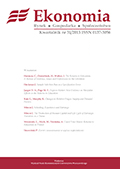Biedni pracujący w XXI wieku
Working Poor in the Twenty-First Century
Author(s): Ewa PolakSubject(s): Economy
Published by: Uniwersytet Warszawski - Wydział Nauk Ekonomicznych
Summary/Abstract: One of the recently observed trends in Poland, as in most other countries, is the increase in the distances between the different income segments of the labor market. This is accompanied by an increase in relative poverty of the employees. In the nineties in the twentieth century the term of working poor appeared. In discussions on poverty, however, many problems are mainly ignored such as: poor workers, fair pay, access to market offers, quality housing, effective health care, modern education and the judiciary. Poverty is mainly associated with unemployment, homelessness and social exclusion. The problem of low salaries is considered a natural consequence ofmarket competition and the skills and labor market activity of individual units. The process of increasing economic stratification is not an autonomous phenomenon, arising only from the different attitudes, life strategies, skills, abilities and determination of individual units, but increasingly it is the consequence of economic liberalization and globalization effect distribution. The existence of poor working reduces the number of unemployed and improves the economic situation of the companies, but generates new problems such as: a growing number of inactive people, unstable employment situation and income, the growing movement of employees, lack of job security, economic and non-economic deprivation of employment, social discontent, social disintegration and hidden unemployment.
Journal: Ekonomia. Rynek, Gospodarka, Społeczeństwo
- Issue Year: 2011
- Issue No: 27
- Page Range: 18-33
- Page Count: 16
- Language: Polish

